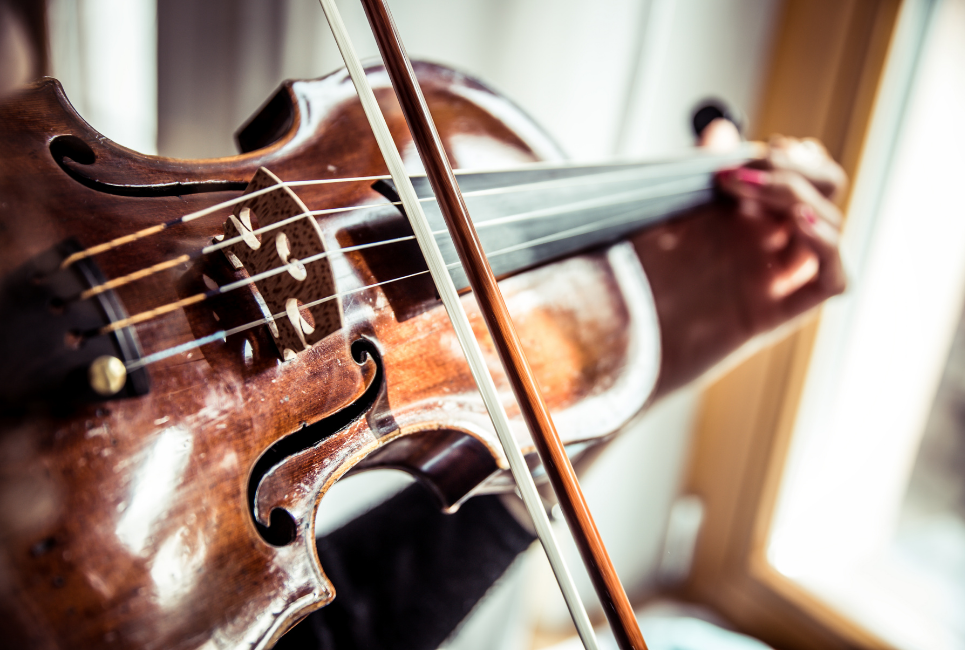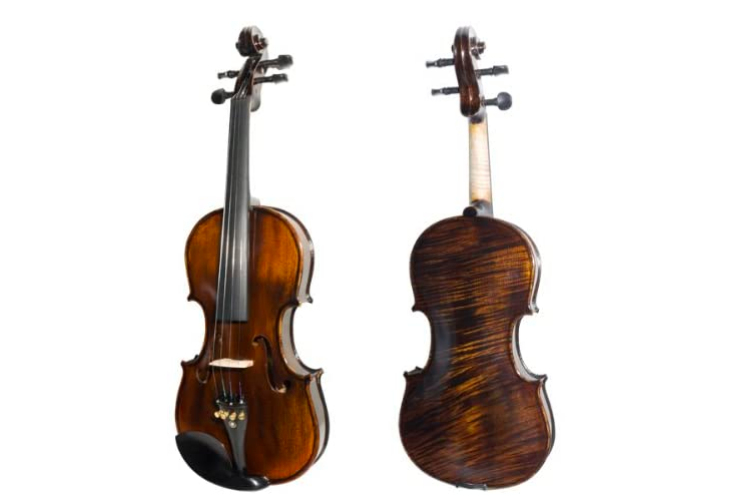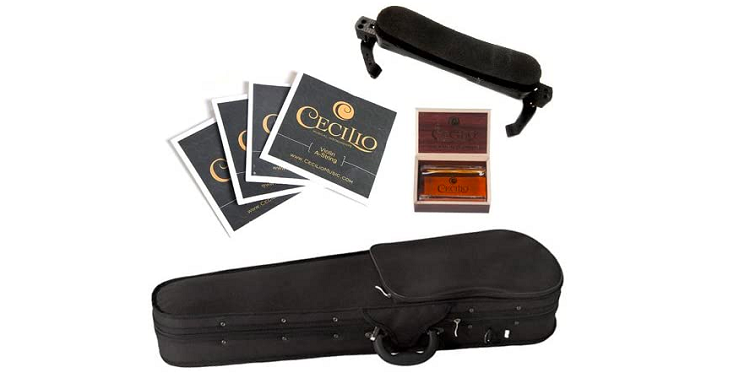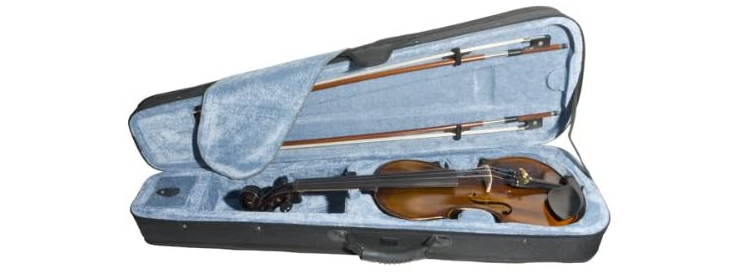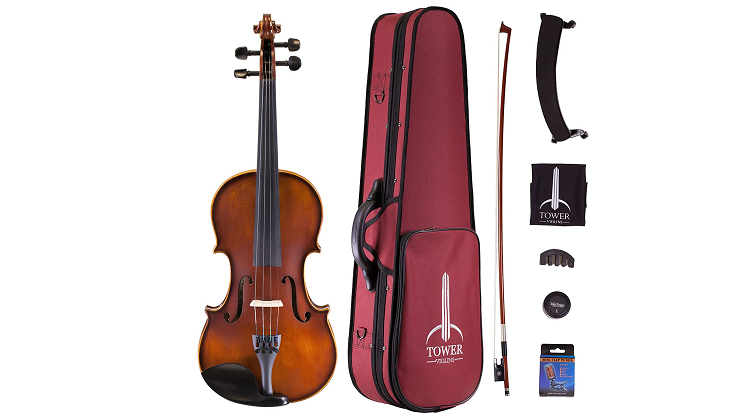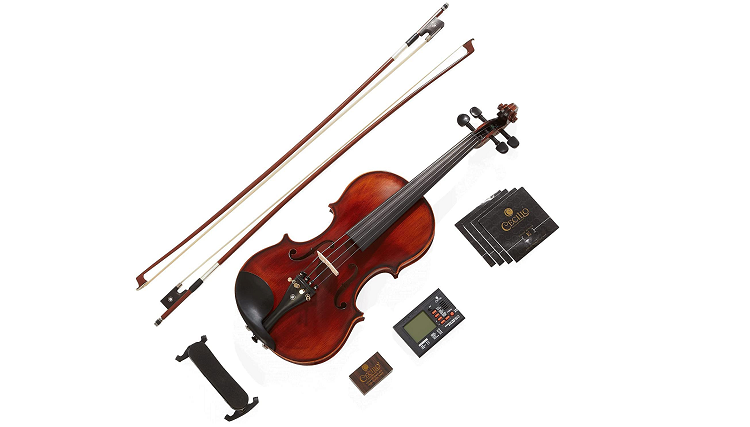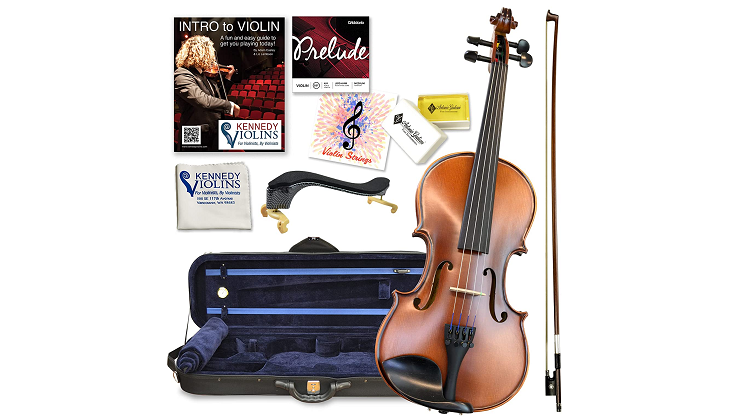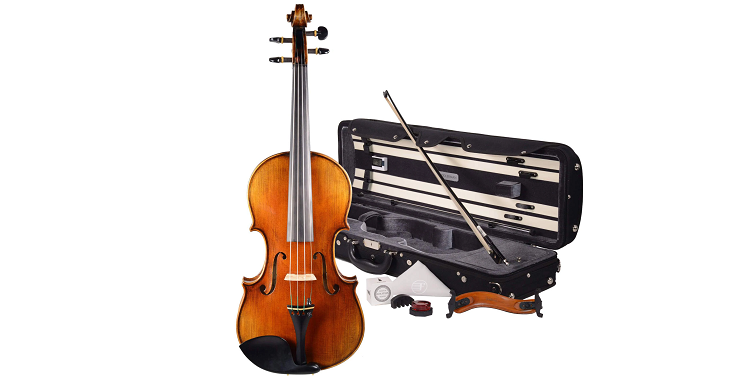- Best Fretted Violins Guide - May 31, 2022
- Best Yamaha Violins Brand Guide - April 13, 2022
- An Honest Mendini MV300 Review - March 31, 2022
Mendini by Cecilio consists of slightly cheaper violins; from model to model, Cecilio and Mendini can be compared spec-wise. In general, I’m fonder of Cecilio branded instruments over Mendini.
The differences in the lower-end models come down to strings and finish color. In their higher-end models, Cecilio branded instruments use better tonewoods, come strung with better strings, and have greater attention to detail.
MV650 is the sister model to the CVN 600, but with several changes that lower the overall quality and the price point, it can’t compete directly with the CVN 600. So how does it compare to other student models? Well, let’s find out!
Pros, Cons, and Bottomline
The MV650 is a gorgeous instrument with its deep dark brown and black flamed finish; unfortunately, at this time, it’s challenging to track down.
If you can find one of these beauties out in the wild, you will want to take it to a luthier to have it assessed and set up. The reviews are generally favorable, but a few mention that it broke or cracked almost immediately or came defective. Usually speaking, Cecilio could do with better quality control.
My overall opinion is that it’s a good student instrument. Still, I don’t expect to get more than a few years out of this violin. For less than 100 dollars more, you can purchase a better student instrument that will last you well into your musical career. If you really want a Mendini violin check out the MV500; it’s nearly identical to the MV650 and currently in stock!
Pros
- Highly flamed one-piece maple back
- Solid hand-carved spruce top
- Ebony fingerboard and fittings
- Comes with all the accessories you need
- Gorgeous dark brown antique finish
Cons
- Poor quality control
- Cheap bows and strings
- Will need set up by a luthier
- Hard to find
Student Violins
Student violins vary in price, quality, and specifications. You can spend anywhere from a hundred dollars to 1000 on a student instrument. The more you spend, the better the instrument, generally speaking. My first violin was 150 dollars from Cecilio themselves, and it reflected that price point in its specifications.
Tonewoods make the violin’s body and are the largest influence on the tone and playability. The violin’s top should be made from solid carved spruce with maple back and sides. Aged European tonewoods are some of the best you can get, but they are considerably more expensive.
Student violins typically feature Chinese harvested tonewoods, especially for Chinese manufactured instruments like Mendini. I’ve seen student models that feature aged wood, but it’s typically less than 10 years. In general, aged wood will give your violin a headstart in the tone department, but it’s not a must-have for a brand new student.
Violin fingerboards are traditionally made from ebony because it is durable and can withstand finger oil, sweat, and dirt. This is true regardless of how expensive or fancy the violin is.
However, cheaper instruments will have fingerboards made from dyed hardwood or maple. I don’t consider these instruments worth purchasing as they are typical of inferior quality.
Student models typically come with ebony fittings or a mix of composite and ebony fittings. The black color is very standard and helps students blend well into an Orchestra or group setting. Still, fittings are a personal choice for many, and others simply don’t care.
They can be made from many different kinds of hardwoods. The great thing about fittings is they can always be changed, although some parts like pegs require a luthier to install.
Suppose you are buying your first violin online. In that case, I suggest taking it to a luthier to be set up and adjusted or at the very least letting your teacher do that for you. After about 3 years, I was comfortable adjusting my violin bridge and even changing certain fittings on my own.
However, as a beginner, even changing the strings was nerve-wracking. Letting a luthier tackle the first setup and show you how to change your strings will relieve significant headaches later.
Student violins come in an outfit with various accessories to get you started. The basics include a case, bow, rosin, and shoulder rest; however, most outfits include cleaning and care accessories and a tuner.
The quality will vary from brand to brand. Still, most higher-end brands like Eastman, Fiddlershop, Cremona, and Kennedy Violins will include better accessories that won’t need to be replaced.
MV650 Features and Review
The MV650 is a stunning instrument. The deep brown and black finish highlights the 1 piece maple back’s flaming. The antiquing on the solid hand-carved spruce top is also gorgeous. I’m a sucker for very dark brown or dark reddish-brown varnish on violins. Something about it screams old and sophisticated.
Since this is a Mendini violin, it doesn’t feature unique tonewoods as their higher-end Cecilio violinists do. Still, the one-piece back is lovely, even if it doesn’t contribute anything tonally to the violin. It’s a safe assumption that this violin is made from basic cheaper Chinese tonewoods.
The fingerboard and fittings are pure ebony, which looks great on this violin. The deep black of the ebony brings out the black in the finish, creating an overall cohesive look.
The tailpiece and pegs have a pearl inlay as decoration, and the tailpiece has four detachable fine tuners. Detachable fine tuners mean that you will put new ones on if they break. This is an excellent addition because Cecilio uses very poor-quality fine tuners on their tailpieces.
Mendini violins come with Cecilio’s in-house brand of strings, which are to put it shortly….crap. The first time I tried them, they broke, and so did the backup set. I eventually gave up and got D’Addario preludes before jumping into the deep end of violin strings. The best thing you can do for your playing takes this violin to a luthier and get it fully set up and adjusted.
They will help you find a good set of strings and may even show you how to change them yourself. When I was a new student, I enjoyed Thomastiks Dominants and the Fiddlershop String Set, which is very similar to their dependability and longevity. D’Addario Preludes are a student standard that I see most people start out with.
The rest of the violin outfit is pretty basic. And includes a case, two bows, rosin, extra strings, an extra bridge, and a tuner. The bows and strings can go in the trash immediately. Cecilio struggles with quality control for their bows, and they are often very unbalanced. I recommend getting a carbon fiber bow from Cadenza, Fiddlershop, or Glasser.
Fiddlershop has some of the cheapest carbon fiber bows on the market, and they offer a variety of styles. I like Cadenza bows a lot, very comfortable to hold, and the leather doesn’t fall off quickly. I’d also recommend a better shoulder rest. Standard student ones are pretty inexpensive and will help a lot with comfort. Kun, Everest, and Fiddlershop all make a variety of shoulder rests.
How Does the MV650 Sound?
When adjusted, this violin has potential, but adjusting it is essential to getting a good tone out of it. I found the violin tone-wise to be incredibly pleasant. It has a soft clear upper register and an excellent even lower register.
I’ll admit at first the violin is tinny out of the case, partially due to the strings and being brand new. New strings will help right away, but they should start to subside after a few months.
Although the pleasant tone of this violin isn’t going to grow like the CVN 600 would because the wood isn’t of the same quality. With that said, it is a good starting instrument and certainly a step up from any of the lower-end Mendini or Cecilio models.
Ultimately, I would recommend this violin, but it’s not my first choice. It’s a lovely violin and has a great tone, but I know there are better instruments out there for only a little bit more.
The most significant disadvantage is that this violin will need to be upgraded in only a few years. While it’s a great starting instrument, I can’t see it taking someone through an entire music program.
Violins I Recommend
Let’s look at some of the violins I recommend for new students. These violins are chosen based on their brand reputation, my personal experience as a violinist, and the price to quality ratio.
Top Choice
My top choice is the Tower Strings Entertainer Violin from Fiddlershop. I’m a fan of Fiddlershop, and even more than that, I’m a fan of the Tower Strings violins. I currently have an electric violin from them that is absolutely spectacular, and I love playing it. The Entertainer violin features solid carved aged spruce and maple tonewoods with an ebony fingerboard and mixed fittings.
The pegs and endpins are ebony, while the tailpiece is carbon composite with 4 built-in fine tuners. The bridge is hand-carved, and it comes strung with D’Addario Prelude strings. The outfit includes a small but quality case, a brazilwood bow, rosin, shoulder rest, polishing cloth, practice mute, and tuner.
Overall it sounds balanced, not too bright or too deep, but it does sound like a student instrument. However, the wood used is of good enough quality; this violin will age and settle to produce a more mature sound over time.
Budget Choice
While the MV650 is difficult to track down, the MV500 is plentiful and nearly identical. These violins retail for roughly the same price at $180 and come with the same specs.
Both feature a solid carved spruce top, and 1 piece flamed maple back. The varnish is very dark and antique on both violins. Additionally, they sound nearly identical and come with the same fittings and accessories.
In some cases, players have even reported the label on the MV500 to actually say MV650, indicating Cecilio has pegged these as the same model. I’m assuming that the MV650 is largely being sold as the MV500. Cecilio has worked on slimming their offerings down and combining highly similar models.
Step Up Choice
Suppose you want to step it up in both quality and price. In that case, the Antonio Giuliani Etude Violin by Kennedy Violins is a beautiful instrument at an affordable price. Kennedy Violins has been around for a long time and consistently produces well-made quality violins for various playing levels and price points.
This violin features dried maple and tight-grained spruce harvested from the Himalayas. The wood is hand-carved, and the violin has an ebony fingerboard and fittings. The bridge is custom fit for the violin. It comes completely hand set up in their US-based workshop with D’Addario Prelude Strings. The violin’s overall tone is very sweet and a little bright.
Still, it’s a good fit for the growing student as it’s not offensive in either direction. The outfit comes with a quality Giuliani brazilwood bow, a Prtoland Oblong case, shoulder rest, extra strings, rosin, a violin book, and a polishing cloth.
High-Quality Choice
Suppose you wanted to step up both quality and price range considerably. In that case, you could consider any of the more expensive Fiddlershop student violins or lower-end intermediate violins. I’m partial to the Fiddlerman Master Violin for those serious and want a violin that they can take with them until they need a professional violin.
The master violin features hand-carved flamed spruce and maple tonewoods that have been dried for at least 10 years. The fingerboard and fittings are pure ebony, and the bridge is either French Despiau 3 or Holstein 3 star. I love the French Despiau bridges and use them on my Eastman violin. The strings are chosen individually based on the violin.
Typically they use Dominants or Vision Solos. I’ve used both and currently use Visions, but on this violin, I prefer Dominants. The overall tone is incredibly mature for the price point and sounds lovely across all registers. Very balanced, neither too bright nor too deep.
FAQ
Answer: Ideally, you won’t set up a violin unless you have played for quite a few years or are a luthier. A new student should only let their teacher or a luthier set up their instrument. Setting up a Mendini or Cecilio instrument typically involves filing and notching or completely replacing the bridge. Along with adjusting the fingerboard and soundpost if needed.
Lastly, the violin will be strung with your preferred strings, giving you the chance to start out with much better strings. While this is an extra cost on top of your violin, it will help a Cecilio or Mendini violin tremendously. Or you can use that money to spend towards a violin that is already set up when you receive it.
Answer: Yes!! Chords are three or more notes played together. A skilled violinist will easily play chords, but intermediate students may struggle.
Answer: Rosin is made by heating beeswax and pine resin together until the terpenes have vaporized then pouring it into a mold. Rosin is very brittle and prone to breaking when dropped at room temperature. When scratched and rubbed on the bow, it becomes a sticky powdery substance that creates friction between the bow and the strings allowing them to vibrate.
Final Thoughts
The MV650 is a great student violin that looks and sounds beautiful. It’s made from quality tonewoods, and for the price, it’s great, but it lacks longevity, which doesn’t make it my first choice for a student violin. It is also hard to find in stock, so I recommend the MV500.
According to buyers, this violin is nearly identical to the MV650 and, in some cases, is the MV650. Suppose you want an all-around good student instrument. In that case, the Tower Strings Entertainer is an inexpensive outfit that will last you several years.
If you want to step up your violin playing the Antonio Guiliani Etude will get you started with everything you need in a high-quality package.
Looking for more interesting readings? Check out:

